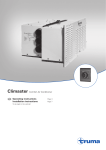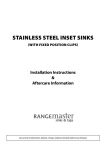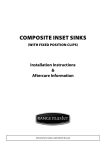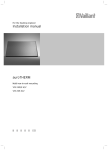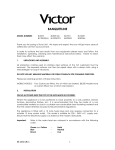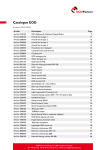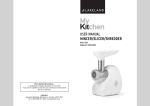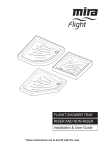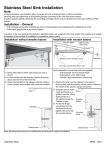Download Rangemaster SN9951
Transcript
SENATOR STAINLESS STEEL INSET SINK WITH FIXED POSITION CLIPS Installation Instructions & Aftercare Information 3966-03 INSTALLATION Installer Please leave this leaflet with the user, as it contains valuable after care advice. Notes Please take care of sharp metal edges before and nn during installation. During installation, take care to protect the sink nn from scuffs and scratches. Avoid straining and overtightening of all plumbing fixtures connected to the sink. nn Carefully check that the moulding and edges of the nn sink are dead level so that water will flow off the drainer. We recommend that the worktop opening is sealed using waterproof sealant, paint or a similar material. nn The clamping brackets are suitable for worktops of nn greater than 36 mm thickness. If your worktop is a different size then it may require packing under the clips or rebating. If flush mounting the sink, we strongly recommend nn that this is carried out by a suitably skilled tradesperson. We recommend that you fit the inset sink to the nn worktop before permanently fixing the worktop to the cabinet. When fitting a tap, we recommend you use a tap nn stabiliser bracket to ensure a secure fit. Installation There are two fitting options (Fig.1): flush mount and sit-on fit. Fig.1 A – Flush fit B – Sit-on fit Due to our policy of continual improvement, we reserve the right to change specifications without prior notice. Flush Mount 1. 2. 3. 4. 5. Using a soft, sharp pencil, mark out the sink top opening dimensions onto the worktop. Draw another line 6 mm inside the sink top outline – this is the cutting line for the opening (Fig.2). Drill as large a hole as possible inside the cutting line. Using a router, padsaw, jigsaw or similar, cut out the opening up to the cutting line. Outer edge for rebate Fig.3 Rebate the worktop up to the outer line (Fig.3). 7. 8. 9. Fit the retaining clips onto the tags around the edge of the sink. Open the hinge on each clip. Apply a thin layer of silicon sealant around the worktop rebate. Turn the sink upside down and lay the worktop over the sink. Swing each clip into place (Fig.4) – this is the most effective method, although if the worktop has been fitted to the cabinet the sink can be placed in the opening and fixed in position from underneath. Centre the sink into the worktop recess. Tighten the fixing screws, a few turns at a time, in the sequence shown in Fig.5. Repeat the sequence until the sink is secure. The clamping brackets are suitable for worktops of greater than 36 mm thickness. If your worktop is a different size then it may require packing under the clips or rebating. nn Cutting line for opening 6 mm Note: The sink edge is nominally 1.2 mm thick so rebate the worktop to a suitable depth, depending on the worktop material, to allow for a layer of silicon sealant providing good adhesion and a watertight seal. 6. Fig.2 Worktop To accurately determine the size of the sink opening measure the dimensions of the sink (manufacturer’s tolerances will cause some variation in the dimensions stated in the ‘Technical Data’). Note: You will also need to allow additional space for the silicon sealant providing the watertight seal. Rebate for the sink edge. Make allowance for silicon sealant. Marked outer line Sink edge: nominal thickness 1.2 mm Worktop Worktop Fig.4 Sink 1 DO NOT tighten fully at first attempt. nn DO NOT overtighten the clips as this may distort the nn sink rim. 2 3 Fig.5 9 5 1 3 7 10. Remove any surplus silicon sealant. 16 15 12 11 14 13 10 6 2 4 8 Sit-on Fit Fig.6 1. Place the sink upside down on the worktop. Position the sink on the worktop as required. Make sure the cabinet framework will clear all parts of the sink. Using a soft, sharp pencil draw around the sink as accurately as possible (Fig.6). Remove the sink. Alternatively, you can use a sink template. For details go to www.rangemaster.co.uk. 2. Fig.7 Worktop 3. 4. Cutting line for opening 6 mm 5. 6. Sink outline 7. Fig.8 Worktop Sink Draw another line 6 mm inside the sink top outline – this is the cutting line for the opening (Fig.7). Drill as large a hole as possible inside the cutting line. Using a padsaw, jigsaw or similar, cut out the opening up to the cutting line. Fit the retaining clips onto the tags around the edge of the sink. Open the hinge on each clip. Apply silicon sealant around the underside of the sink outer edge. Turn the sink upside down and lay the worktop over the sink. Swing each clip into place (Fig.8) – this is the most effective method, although if the worktop has been fitted to the cabinet the sink can be placed in the opening and fixed in position from underneath. Centre the sink. Tighten the fixing screws, a few turns at a time, in the sequence shown in Fig.9. Repeat the sequence until the sink is secure. The clamping brackets are suitable for worktops of greater than 36 mm thickness. If your worktop is a different size then it may require packing under the clips or rebating. nn 1 2 DO NOT tighten fully at first attempt. nn DO NOT overtighten the clips as this may distort the nn sink rim. 3 8. Fig.9 9 5 1 3 7 16 15 12 11 14 13 10 6 2 4 8 Remove any surplus silicon sealant. Fitting the Overflow Pipework Fig.10 The overflow pipework for the sink will require modifying to fit. Cut the part as shown (Fig.10). Fit the overflow pipework together as normal. To provide a watertight seal, apply silicon sealant onto the sink-side face of the rubber seal before fitting it to the sink (Fig.11). 27 mm 110 mm Rubber seal Fig.11 Sink-side face Silicon sealant Technical Data Senator 1.5 Bowl Sink Sink edge thickness 1.2 nominal 180+20 340+20 220+20 +2 0 972±0.5 990 +20 +2 0 R3 all corners 400 +20 +2 0 513+20 +2 0 Worktop cut-out 990+20 978 +2 0 All dimensions in millimetres +2 +2 00 513+20 525 +2 0 Senator 1.0 Bowl Sink Sink edge thickness 1.2 nominal 500+20 220+20 +2 0 972±0.5 990 +20 +2 0 R3 all corners 400 +20 +2 0 513+20 +2 0 Worktop cut-out 990+20 978 +2 0 All dimensions in millimetres +2 +2 00 513+20 525 +2 0 AFTER CARE Day-to-day Care Routine cleaning of your stainless steel sink is easy if the following simple procedure is followed: After use wipe the bowl and drainer with a soft damp soapy cloth and rinse with clean water. In hard water areas, an application of proprietary cream cleaner or stainless steel sink cleaner will avoid any build-up of a dull film of waterborne deposits. Although stainless steel is an extremely durable material and will withstand a great deal of hard use, it can be scratched by hard or sharp objects. If the surfaces are to be kept in a blemish free condition reasonable care should be taken when handling such items. Cleaning Always use a soft cloth. The use of coarse grit scouring powders or soap-filled wire wool cleaning pads is not recommended, since both will mark the surface of the sink. Wire wool pads can leave tiny fragments of wire embedded in the surface and these can rust and leave small brown rust stains. Vigorous rubbing with a soft cloth with a proprietary cream cleaner or stainless steel sink cleaner will remove these stains. Always remove wet cleaning aids (cloths, containers, etc.) from the sink surface after use to avoid the formation of water marks and rust stains. Discolouration and Heavy Staining In most cases, staining of stainless steel is due to something being deposited on the steel rather than an attack on the material itself. The most common cause of staining is the build-up of a thin film of waterborne deposits on the sink surface, often first seen as a rainbow effect. The build-up of such a film can be avoided by drying the surface of the sink after use. Should such a film appear, apply proprietary cream cleaner or stainless steel sink cleaner neat and rub vigorously with a damp cloth along the length of the sink surface. After cleaning, rinse thoroughly with clean water and dry. Wire wool products and ferrous water supply pipes can leave minute ferrous particles adhered to the sink surface. Since stainless steel under normal conditions does not rust, these particles can cause the appearance of small brown rust stains. These stains can be removed using the procedure described above. Bleaches should always be used in the prescribed strength specified by the manufacturers. Undiluted bleaches can cause pitting and staining of the surface and should be immediately rinsed off with plenty of clean water. All cleaning agents containing hypochlorites are unsuitable for use with stainless steel and, even highly diluted, can cause pitting under certain circumstances. For this reason we strongly recommend that the sink is not used for soaking clothes or cleaning clothes in hypochlorite solutions for long periods. 2. Silver Dip Cleaners These are particularly harmful since they contain strong acids that can cause discolouration and pitting. The first sign of this is an iridescent rainbow stain that turns an etched dull grey colour. Should any silver dip cleaner come into contact with the surface of the sink it should be immediately rinsed off with plenty of clean water. 3. Corrosive Foodstuffs Fruit juices, damp salt, vinegar, ready made mustards, pickle and mayonnaise can cause pitting and corrosion if left in contact with the stainless steel surface for long periods. 4. Acids Sulphuric, Hydrochloric and other strong acids will cause pitting corrosion, as will photographic developing liquids. If contact occurs immediately wash off with plenty of clean water. 25 Year Guarantee We guarantee to replace any stainless steel sink that breaks due to material or manufacturing defects within 25 years from the date of purchase. The guarantee does not cover normal wear and tear occurring through use of the product. For the guarantee to apply the owner must follow the use, care and cleaning instructions provided. Accessories and waste fittings are not included in this guarantee. Caution! Certain household products contain substances that will attack the stainless steel surface. They are: 1. Bleaches Most common domestic bleaches contain Chlorine in the form of a hypochlorite. Chlorine attacks the microscopic Chromium Oxide film on the surface and can cause pitting of the surface. Meadow Lane, Long Eaton, Nottingham, NG10 2GD, England Tel: +44 (0) 115 946 4000 Fax: +44 (0) 115 973 6602 E-mail: [email protected] w w w.rangemaster.co.uk 13 EN 13310 : 2003 Stainless Steel Kitchen sink made of: Cleanability: Pass Load resistance: Durability: NPD / N/A Pass










